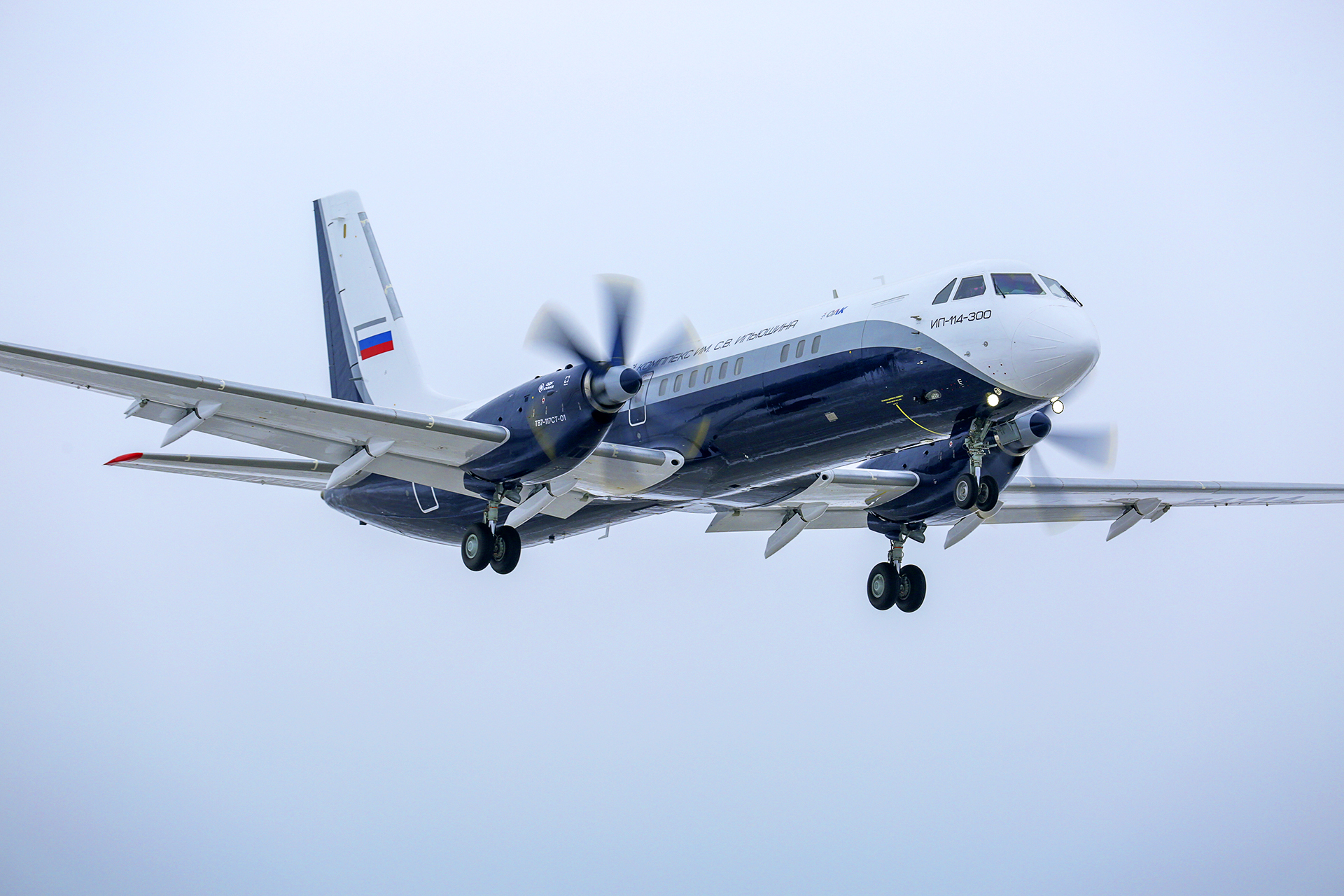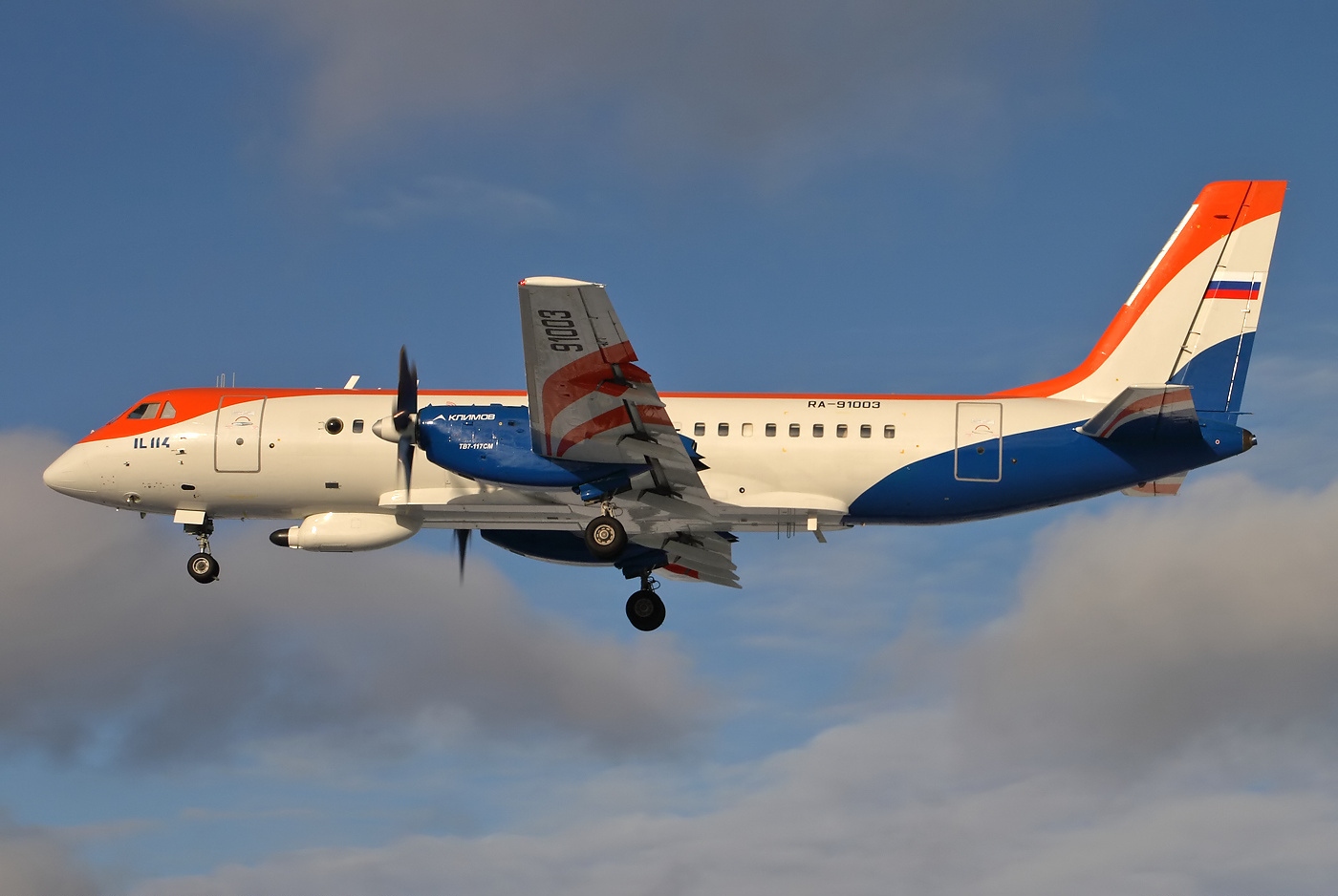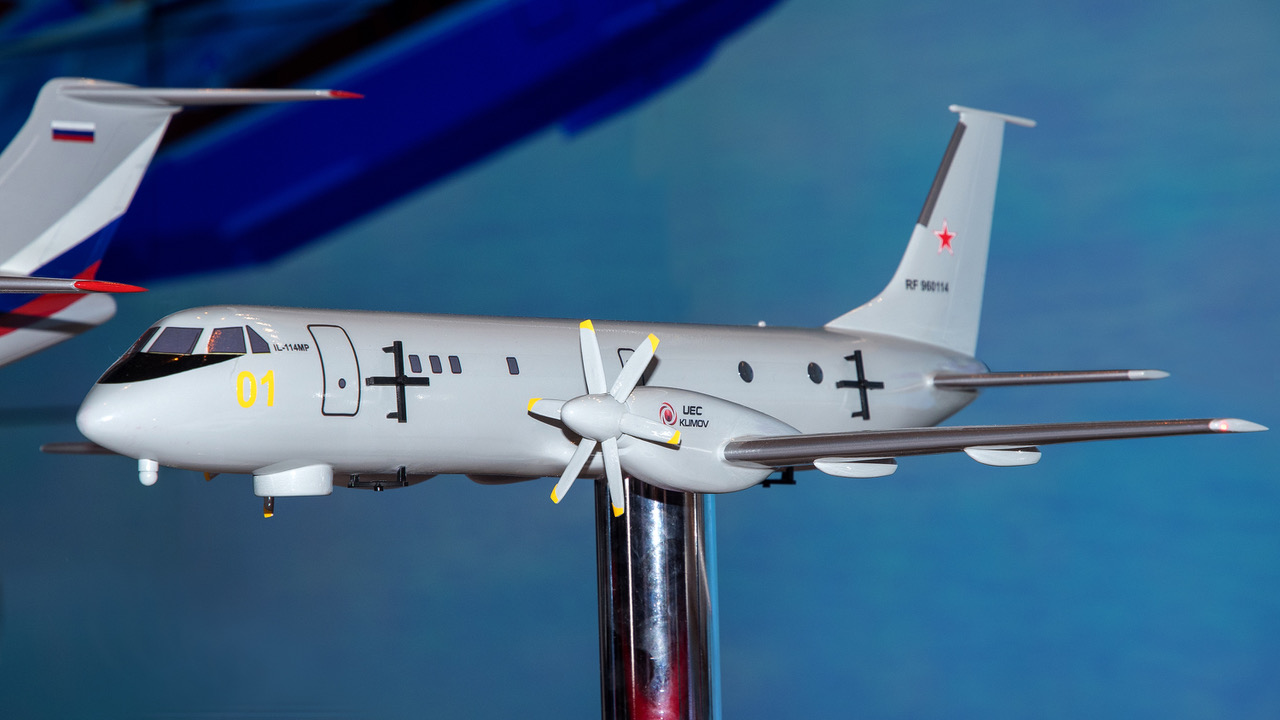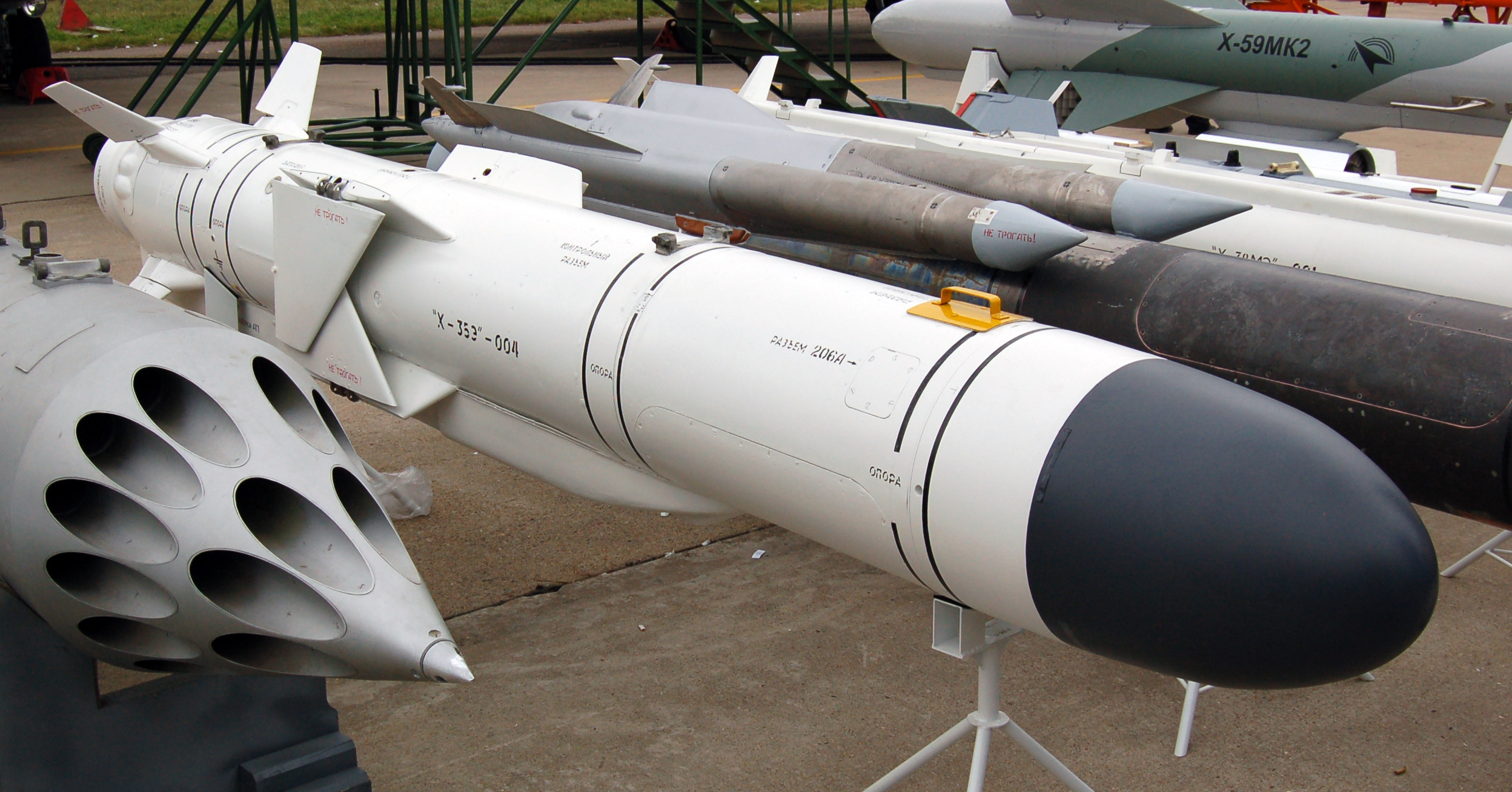Russia’s United Aircraft Corporation today completed a successful first flight of the new Ilyushin Il-114-300 turboprop aircraft. Although billed primarily as a regional passenger transport, it’s anticipated that the platform could eventually serve as the basis for a variety of military special-mission aircraft, superseding a number of Cold War-era types now in service with the Russian military, including aging electronic warfare and maritime patrol platforms.
The Il-114-300’s maiden flight took place at Zhukovsky, outside Moscow, with a crew consisting of Ilyushin’s chief pilot Nikolai Kuimov, test pilot Dmitry Komarov, and onboard test engineer Oleg Gryazev.

To long-term observers of Russia’s aerospace industries, the twin-turboprop Il-114-300 may look familiar. In fact, the original Il-114 prototype first flew back in 1990, when there were high hopes that it could be a pioneering, Western-oriented regional airliner tailored for the Perestroika-era market.
When it first took to the air, the Soviet Union was still intact, and production of the 64-seat Il-114 airliner was assigned to a factory in Tashkent, in what then the Uzbek Soviet Socialist Republic. A year later, the Soviet Union was disintegrating and only 15 production Il-114s ever came out of the Tashkent plant, between 1992 and 2012. Uptake among airlines was, unsurprisingly, limited.

Currently, there is only thought to be one of the original Il-114s flying anywhere in the world. This is the specially adapted Il-114LL “flying laboratory” that’s used by Russia’s Radar MMS company for trials of new radars and other avionics.

The basic design of the Il-114 was sound, though, and in 2015 Russia decided that it would itself relaunch production of the aircraft, in a new, updated, and “Russianized” form. This is the Il-114-300 that differs primarily in its choice of powerplant.
With a view to selling Il-114s around the globe, the original design featured turboprops from Pratt & Whitney Canada, as well as avionics supplied by American firm Rockwell Collins. In its Il-114-300 form, the aircraft is equipped with Russian-made Klimov TV7-117ST-01 turboprops — each developing 3,100 horsepower — plus Russian avionics. This makes it more suitable for the domestic market, especially in more remote regions, where the support of Western-made equipment is limited and, importantly, could allow it to be more readily adapted for military use.
The president of the United Aircraft Corporation (UAC), Yuri Slyusar has already said that military versions of the Il-114-300 will be developed to replace the “old Ilyushin airplanes with special systems.” Although he didn’t mention any aircraft by name, it’s fairly clear that Slyusar was referring to a range of types that were developed many years ago in the Soviet Union on the basis of another Ilyushin turboprop airliner, the Il-18. The resulting military aircraft were the Il-20 Coot electronic intelligence (ELINT) aircraft that first flew in 1969, the Il-22 Coot airborne command post and electronic warfare aircraft that was first flown in 1970, and the Il-38 May maritime patrol aircraft that dates back to 1961. The first two of these still serve with the Russian Aerospace Forces, or VKS, while the Il-38 continues to be flown by the Russian Navy. All have been periodically upgraded since entering service.



Back in the late 1990s, Ilyushin had unveiled plans for the Il-114PR and Il-114PRP versions that would have carried various signal intelligence and electronic warfare payloads, together with a maritime patrol derivative of the same platform known variously as the Il-114MP and Il-138. There was also a proposed Il-140 airborne early warning and control version, but this requirement would seem to have vanished now that work is well underway on the larger and more capable A-100, which is a more advanced development of the existing A-50 Mainstay that The War Zone has discussed in detail in the past.
Of all the proposed Il-114-300 military derivatives, we currently know most about the Il-114MP. This version is intended to supersede the Il-38 and would be equipped for maritime patrol, including sensors for detection and tracking of both surface vessels and submarines, and weapons for attacking them.

The overall mission system for this aircraft is known as Kasatka, Russian for killer whale, which includes a radar and an electro-optical turret, as well as a sonobuoy system, magnetic anomaly detector, and electronic support measures for detecting radio transmissions. The 360-degree radar would be installed under the fuselage, the electro-optical turret below the nose, the magnetic anomaly detector atop the tail fin, and the six electronic support measures antennas distributed around the fuselage. Trials of the Kasatka system have already taken place using the Il-114LL testbed.
Planned armament for the Il-114MP includes a pair of Kh-35 (AS-20 Kayak) subsonic anti-ship missiles, variants of which already serve Russia in ground-launched and ship-based forms. Alternatively, aerial mines could be carried.

In August 2019, Russian media outlet Interfax quoted Denis Manturov, the head of the Russian Ministry of Industry and Trade, as saying that plans were already underway to develop replacements for both the Il-38 and the larger Tu-142 Bear-F maritime patrol aircraft, the latter derived from the Tu-95 Bear bomber and missile-carrier.

“The Ministry of Defense recently set the task for developers to prepare proposals for the creation of a new patrol aircraft based on existing models,” Manturov said, adding that a “fundamental choice” would be made in 2019.
It’s not clear whether the Russian Ministry of Defense has already formally selected the Il-114MP and, if so, whether it is intended to replace the Il-38 and the Tu-142. Another option would be to further upgrade the Tu-142, the airframes of which still have many remaining flying hours, the most recent having been completed in the mid-1990s. Furthermore, the Kasatka suite has also been suggested as an upgrade for the Russian Navy Bears.
Ilyushin has also pitched a less-sophisticated maritime patrol version of the aircraft, the Il-114P, which would be suitable for patrol of littoral zones including maritime borders and economic zones, or alternatively for ecological monitoring, including aerial pollution reconnaissance. This would be fitted with a pared-down version of the Kasatka suite, with only the radar and electro-optical turret. Other optional stores would include various pods carrying, for example, guns, searchlights, loudspeakers, or rescue equipment.
The Il-114P might be attractive to paramilitary operators in Russia, such as the Federal Security Service, better known by its Russian acronym FSB, which currently uses around half a dozen twin-turbofan An-72P aircraft for armed transport and patrol.

Other military or paramilitary derivatives of the Il-114-300 have been discussed, too. These include the Il-114-300L, the latter equipped with skids for Arctic operations. With Moscow’s increasing focus on the Arctic as a potential theater of military operations, this variant could find a use in supporting the country’s bases in the region.
It remains to be seen how realistic all these plans are, especially since the Il-114-300 program itself has suffered some delays. Originally, the Il-114-300 was planned to make its first flight in September 2020. What is more, the prototype is actually a reworked example of the original Il-114, utilizing an airframe that was completed in Tashkent in 1994. Meanwhile, even official industry estimates foresee a demand for only around 30 aircraft to meet the needs of Russian airlines, although Russia’s Deputy Prime Minister Dmitry Rogozin has confidently predicted a production run of “at least 150,” plus more for the military. There are no records of firm orders so far.
Should the Il-114-300 enter series production, for civil and/or military customers, it will be built at the Lukhovitsy plant near Moscow. Slyusar has said that up to 12 examples could be built there annually. This would be welcome work for the factory, which is otherwise responsible for manufacturing the MiG-29M and MiG-35 multirole fighter jets, orders for which have been limited, especially on the domestic front. There is likely limited potential for follow-on fighter work here, too, with prospects of building a new Russian lightweight fighter seemingly remote, as we have discussed in the recent past.
A first fully Russian-made Il-114-300 is not expected to be completed before 2021, with tentative plans for operational service, in passenger configuration, from 2023. Thereafter, time will tell if the aircraft provides a much-needed successor to some of Russia’s military special-mission platforms.
Contact the author: thomas@thedrive.com
